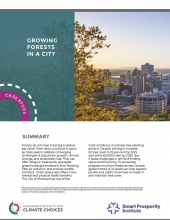This case study is part of a collaborative series between the Canadian Institute for Climate Choices and the Smart Prosperity Institute exploring the value of urban natural infrastructure within the context of climate change and other economic, environmental and societal objectives. Other case studies in the series cover green roofs and wetlands.
Forests do not have to be big to deliver big value. Their value continues to grow as cities seek to address converging challenges of population growth, climate change, and biodiversity loss. They can offer refuge in heatwaves, sequester greenhouse gas emissions, limit flooding, filter air pollution, and provide wildlife corridors. Green space also offers many mental and physical health benefits.
The City of Montreal has one of the most ambitious municipal tree planting plans in Canada, aiming to increase its tree cover to 25 per cent by 2025 and plant 500,000 trees by 2030. But it faces challenges in terms of finding space and financing. To accelerate progress on urban forests across Canada, governments of all levels can help expand private and public incentives to invest in and maintain tree cover.
READ THE CASE STUDY: Growing Forests in a City
Also in this series:



